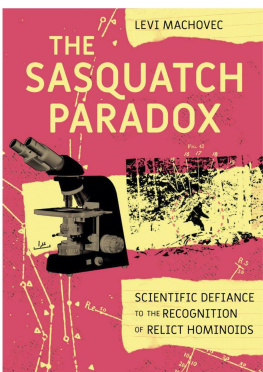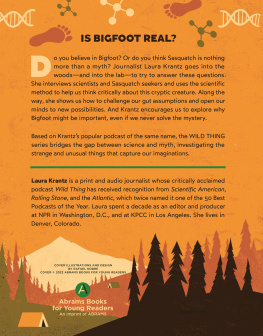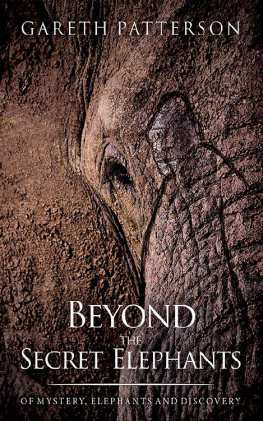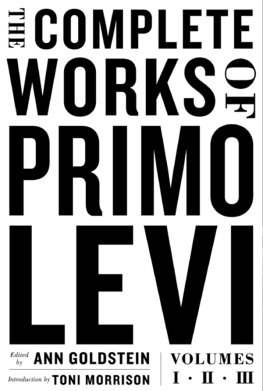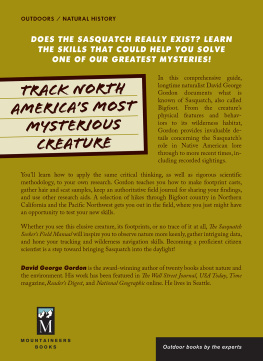Levi Machovec - The Sasquatch Paradox: The Scientific Defiance to the Recognition of Relict Hominoids
Here you can read online Levi Machovec - The Sasquatch Paradox: The Scientific Defiance to the Recognition of Relict Hominoids full text of the book (entire story) in english for free. Download pdf and epub, get meaning, cover and reviews about this ebook. year: 2022, publisher: Untold Publishing, genre: Science. Description of the work, (preface) as well as reviews are available. Best literature library LitArk.com created for fans of good reading and offers a wide selection of genres:
Romance novel
Science fiction
Adventure
Detective
Science
History
Home and family
Prose
Art
Politics
Computer
Non-fiction
Religion
Business
Children
Humor
Choose a favorite category and find really read worthwhile books. Enjoy immersion in the world of imagination, feel the emotions of the characters or learn something new for yourself, make an fascinating discovery.
- Book:The Sasquatch Paradox: The Scientific Defiance to the Recognition of Relict Hominoids
- Author:
- Publisher:Untold Publishing
- Genre:
- Year:2022
- Rating:3 / 5
- Favourites:Add to favourites
- Your mark:
- 60
- 1
- 2
- 3
- 4
- 5
The Sasquatch Paradox: The Scientific Defiance to the Recognition of Relict Hominoids: summary, description and annotation
We offer to read an annotation, description, summary or preface (depends on what the author of the book "The Sasquatch Paradox: The Scientific Defiance to the Recognition of Relict Hominoids" wrote himself). If you haven't found the necessary information about the book — write in the comments, we will try to find it.
Levi Machovec: author's other books
Who wrote The Sasquatch Paradox: The Scientific Defiance to the Recognition of Relict Hominoids? Find out the surname, the name of the author of the book and a list of all author's works by series.
The Sasquatch Paradox: The Scientific Defiance to the Recognition of Relict Hominoids — read online for free the complete book (whole text) full work
Below is the text of the book, divided by pages. System saving the place of the last page read, allows you to conveniently read the book "The Sasquatch Paradox: The Scientific Defiance to the Recognition of Relict Hominoids" online for free, without having to search again every time where you left off. Put a bookmark, and you can go to the page where you finished reading at any time.
Font size:
Interval:
Bookmark:
THE SASQUATCH PARADOX
LEVI MACHOVEC
Copyright 2022 by Levi Machovec
All rights reserved.
No part of this book may be reproduced in any form or by any electronic or mechanical means, including information storage and retrieval systems, without written permission from the author, except for the use of brief quotations in a book review.
1. The Patterson-Gimlin Film
2. The Myakka Ape Photos
3. Footprints
4. Native American History
5. History of Scientific Resistance
6. The Sasquatch Paradox
7. Assumptions
8. The Cure
9. Conclusion
After writing A Quest for the Truth, which at the time I believe represented the pinnacle of my capabilities, something dawned on me. One book would simply not be enough for me to fully expand on the ideas needed to further legitimize my argument. As proud as I was of my first book, I must admit that it was far from perfect. At the time, I was hindered by the challenges of self-publishing, the rushed nature of the books release (due to relocating to an area three hours from home), as well as the ignorance that comes from writing and publishing a book for the first time. Rereading my original book left me with mixed emotions. As stated above, publishing the book was an achievement of which I was proud in and of itself. However, the competitive person within was left feeling somewhat deflated. I want to hold myself entirely accountable for my own mistakes and those in my first book. First, there were many grammatical errors in the book. As far as I am concerned, one grammatical error is too much. The editor that I had for the first book was nothing short of phenomenal, but I feel that I let him down by having a book with grammatical mistakes in it. I focused too much on getting the book published and released. I did not slow down enough to catch the mistakes I had made.
As for the title, there are some who disagree with my calling myself a historian. Here are my thoughts on this controversy. First, I believe that an undergraduate degree is sufficient for calling oneself a historian. However, I concede that there are some who believe that this title is earned through a graduate degree. Second, my belief was that I had earned the title by having written and published a book on a historical topic. Third, as a young man trying to make a name for himself in a field that lacks serious consideration from major academic and scientific institutions, I acknowledge that one can say that I stretched my title to make me appear more qualified than what some skeptics would consider me to be. So, if my use of this title offended you, or if you feel that I have not yet earned the label historian, I would like to sincerely apologize. My intentions were not to claim to be something that I am not. My intent was only to open the eyes of the readers to the phenomenon that is Sasquatch.
Here is my promise to you. I promise that this book will in no way have been rushed and that I will hold the end product to the highest standard of that which I want to produce. Although some parts of the book cover the same material as A Quest for the Truth, I have reorganized these sections into a more cohesive and concise structure. Additionally, I expand on some of the ideas presented in the first bookmainly on the Patterson Gimlin Film. One last thing before we get to the book. To all of those who are reading this book, and to all of those who purchased my first, the fact that you are open-minded enough to read a book on this topic makes me truly grateful. You have my sincerest thanks, and I truly hope that you enjoy this book.
The book you are holding right now shares many similarities with my first, A Quest for the Truth. While there are many similarities between the two, the differences far outnumber them. The subject remains the same, but the argument has changed. The first books sole purpose was to argue for the existence of Sasquatch by show demonstrating that there is, in fact, sufficient evidence to warrant scientific investigation. While this book shares a similar theme, the main argument has changed.
We will still review the best evidence for the existence of Sasquatches. Much of the evidence used is the same as that in A Quest for the Truth. And yet, the ideas presented in that book must be expanded upon. After examining the evidence, this book will seek to explore and explain why the Sasquatch as a subject has yet to be taken seriously by the scientific community. Of course, there has always been natural resistance to any discovery made throughout history, especially after the formation of the scientific process. However, in terms of the subject of Sasquatches, something else entirely has happened. The natural resistance to an idea, any idea, was meant to cull the weak from the strong theories, thereby refining and bolstering the arguments in its favor. With the notion of Sasquatches, academic skepticism has subtly morphed into artificial defiance that threatens to indefinitely postpone the (re)discovery of relict hominoids. The term relict hominoids refer to Sasquatch-like entities from around the globe that have managed to survive extinction.
The research from my first book laid the foundation for the research into this book. From my investigations, it was obvious that a strange phenomenon was occurring in the scientific community, one which I was (at the time) unable to name. After continued research and contemplation of the evidence, I could finally label this phenomenon: artificial defiance. The book gets its title from this defiance (which will be discussed in greater detail in the second half of the book). The explanation of artificial defiance would be of little consequence to you if you were unaware of the high-quality evidence that exists.
As you read The Sasquatch Paradox: Scientific Defiance to the Recognition of Relict Hominoids, keep this quote, which the Devil himself once told Napoleon Hill, firmly in mind, Remember this: everything having a real existence is capable of proof.
This is your last chance. After this, there is no turning back. You take the blue pillthe story ends, you wake up in your bed and believe whatever you want to believe. You take the red pillyou stay in Wonderland, and I show you how deep the rabbit hole goes. Remember: all I'm offering is the truth. Nothing more.
In 1982, Ridley Scott released one of the greatest movies of all time, the science fiction classic Blade Runner . If you have read my first book, you may have an inkling of where I am going with this section. Sitting on the roof of an abandoned building, Rick Deckard, played by Harrison Ford, is confronted by the psychotic replicant Roy Batty, played by Rutget Hauer. On that rooftop, Batty (Hauer) delivers one of the most iconic lines in movie history (quoted at the beginning of A Quest for the Truth ). Deckard is trapped by the physically superior Batty, who is near death. As he corners Deckard, he approaches as if he were a tiger just about to take down its prey. However, something miraculous happens. Instead of killing Deckard, Batty delivers his famous monolog, which begins with the iconic words forever etched in the memory of movie fans: Ive seen things you people wouldnt believe. Anyone watching this scene would undoubtedly feel chills running down their spine. The evil replicant that was trying to kill anyone who stood in the way of its freedom had a chance to avenge his comrades. However, he chose to remain peaceful, showing Deckardwho was tasked with ridding the world of these defunct replicantsthat they all wanted the same thing as him: to live.
So much can be written about the magnitude of the movie as a whole and that line specifically, but we must return our attention to Battys iconic line, Ive seen things you people wouldnt believe. Its significance lies in the fact that it helps show us that what we thought of the replicants was simply and utterly false. However, the quote has a meaning outside of the movie that is applicable to a certain segment of the population. There exists a proportion of the populationmuch larger than one might assumethat claim to have seen something that you people wouldnt believe. That something goes by many names, none more famous (or, perhaps, infamous) than Bigfoot.
Next pageFont size:
Interval:
Bookmark:
Similar books «The Sasquatch Paradox: The Scientific Defiance to the Recognition of Relict Hominoids»
Look at similar books to The Sasquatch Paradox: The Scientific Defiance to the Recognition of Relict Hominoids. We have selected literature similar in name and meaning in the hope of providing readers with more options to find new, interesting, not yet read works.
Discussion, reviews of the book The Sasquatch Paradox: The Scientific Defiance to the Recognition of Relict Hominoids and just readers' own opinions. Leave your comments, write what you think about the work, its meaning or the main characters. Specify what exactly you liked and what you didn't like, and why you think so.

